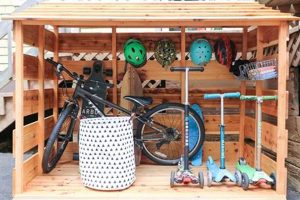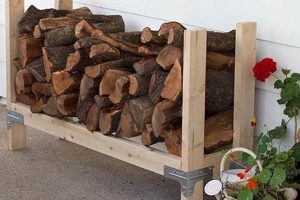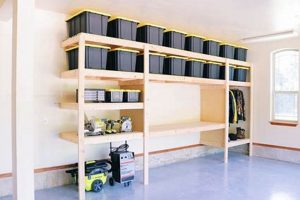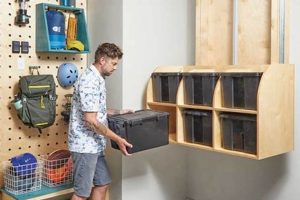Creative solutions for organizing and displaying vinyl collections through self-made constructions are numerous. These constructions range from repurposed furniture to bespoke shelving units, providing alternatives to commercially available storage options. An example includes transforming old wooden crates into modular shelving units, which allows customization based on the size of the record collection.
The significance of custom-built spaces for housing music collections lies in their adaptability and personalization. This approach allows collectors to tailor their storage to specific space constraints and aesthetic preferences. Historically, individuals have sought innovative ways to preserve and showcase their valued music holdings, leading to a diverse array of self-made approaches that reflect both functionality and personal style.
Considerations when approaching the creation of individualized storage for vinyl involve material selection, structural integrity, and aesthetic integration. Subsequent discussions will explore practical approaches to constructing functional and visually appealing solutions for safely and effectively storing records.
Construction and Design Guidance
Effective construction of personalized solutions for organizing vinyl records necessitates careful planning and execution. The following guidelines offer insights for creating robust and aesthetically pleasing storage options.
Tip 1: Assess Collection Size: Begin by quantifying the volume of records to be stored. This determines the necessary dimensions and load-bearing requirements of the structure.
Tip 2: Evaluate Available Space: Accurately measure the designated area for the storage unit. Account for clearances and potential obstructions to ensure a seamless fit.
Tip 3: Select Durable Materials: Opt for materials such as solid wood, plywood, or metal that can withstand the weight of vinyl records over time. Reinforce joints and connections for added stability.
Tip 4: Prioritize Proper Record Orientation: Design shelves or compartments that allow records to stand upright, preventing warping and damage to the vinyl. Vertical support dividers are recommended.
Tip 5: Incorporate Adequate Support: Distribute the weight of the records evenly across the entire structure. Avoid overloading individual shelves or sections to prevent sagging or collapse.
Tip 6: Consider Ventilation: Ensure adequate airflow around the records to prevent the build-up of moisture and humidity, which can damage the vinyl and sleeves.
Tip 7: Emphasize Stability: Anchor the storage unit to the wall to prevent tipping, especially in areas with high traffic or seismic activity. Utilize appropriate hardware for the wall type.
By following these guidelines, individuals can create durable, functional, and visually appealing spaces for preserving and displaying their music collections.
The subsequent section will address aesthetic considerations in the design and integration of the storage unit within the existing environment.
1. Material Durability
Material durability is paramount in the execution of self-constructed solutions for storing vinyl records. The inherent weight of vinyl, combined with the potential for long-term storage, necessitates the selection of materials that can withstand significant stress without degradation.
- Load-Bearing Capacity
The chosen material must possess adequate load-bearing capacity to support the weight of a fully stocked storage unit. For instance, solid hardwoods like oak or maple exhibit superior strength compared to particleboard. Insufficient load-bearing capacity can lead to shelf sagging, structural failure, and potential damage to the record collection.
- Resistance to Environmental Factors
Materials must demonstrate resistance to environmental factors such as humidity and temperature fluctuations. Excessive moisture can cause warping or mold growth, compromising both the storage unit and the records themselves. Materials like treated plywood or powder-coated metal offer enhanced protection against these elements.
- Long-Term Stability
The material’s ability to maintain its structural integrity over an extended period is crucial. Some materials, like certain types of softwood, may be prone to warping or cracking over time, particularly under sustained pressure. Opting for materials known for their long-term stability, even if they require a higher initial investment, ensures the longevity of the storage solution.
- Joint Strength and Fastener Compatibility
The chosen material must facilitate strong and reliable joint construction. Compatibility with various fasteners (screws, nails, adhesives) is essential for creating a stable and durable structure. Weak joints can compromise the overall integrity of the storage unit, potentially leading to collapse. Material selection should consider the specific joinery methods to be employed.
The selection of durable materials directly impacts the long-term viability and protective capability of individualized vinyl record storage. Diligence in choosing appropriate materials safeguards the investment in both the storage solution and the record collection itself.
2. Space Optimization
Space optimization is a critical consideration in the design and implementation of self-constructed vinyl record storage. Efficient utilization of available area ensures maximum storage capacity while minimizing spatial intrusion within a given environment.
- Vertical Storage Solutions
Vertical storage maximizes the use of height, rather than floor space. Implementing shelving units that extend upwards allows for a greater volume of records to be stored within a smaller footprint. For example, constructing floor-to-ceiling shelving along a wall can significantly increase storage capacity without sacrificing valuable floor area. This approach is particularly beneficial in constrained living spaces.
- Modular Design and Customization
Modular systems offer flexibility and adaptability for diverse spatial configurations. Building storage units in modular components enables reconfiguration and expansion as the record collection grows or spatial needs evolve. A system using stackable cubes or interlocking shelves provides customization options for fitting into irregular spaces or accommodating specific collection sizes. This prevents wasted space and ensures efficient utilization of the available area.
- Multipurpose Furniture Integration
Integrating record storage into existing or newly constructed furniture can optimize space utilization. A bench with built-in shelving beneath the seating area provides both functional seating and storage. Similarly, incorporating record storage into the base of a bookshelf or media console combines multiple functions within a single unit. This approach minimizes the need for dedicated storage units, thereby conserving space.
- Utilization of Underutilized Areas
Identifying and utilizing underutilized areas, such as corners or spaces beneath staircases, offers opportunities for discreet storage solutions. Corner shelving units or custom-built storage compartments within alcoves can transform previously unusable spaces into functional storage areas. This strategy maximizes the potential of the available space and minimizes clutter.
The strategic implementation of space optimization techniques is integral to the success of individualized vinyl record storage solutions. By maximizing vertical space, employing modular design, integrating storage into existing furniture, and utilizing underutilized areas, individuals can create efficient and aesthetically pleasing spaces for preserving and enjoying their record collections.
3. Structural Integrity
Structural integrity is a non-negotiable component of self-constructed vinyl record storage. The weight of vinyl records, when aggregated, poses a significant load. Inadequate structural design or execution directly results in compromised stability, leading to potential collapse or damage to both the storage unit and the records it contains. The cause-and-effect relationship is clear: insufficient load-bearing capacity leads to structural failure. The importance of robust construction is underscored by the long-term investment value of vinyl collections; compromised storage directly threatens this investment.
Practical application of this understanding involves several key considerations. Material selection must prioritize strength and durability. For example, using thin particleboard for shelving is a common error, often resulting in sagging or breakage under the weight of a full shelf of records. Employing reinforced joinery techniques, such as using screws and glue instead of nails alone, is crucial. Furthermore, understanding weight distribution principles is essential; evenly distributing the load across the structure minimizes stress on individual components. A real-life example might involve a DIY shelving unit constructed from repurposed pallets. While aesthetically appealing, pallets often require significant reinforcement to safely support the weight of records, particularly at the pallet joints.
In summary, structural integrity forms the bedrock of viable individualized vinyl record storage. Neglecting this aspect represents a critical oversight with potentially costly consequences. Addressing structural concerns through appropriate material selection, robust construction techniques, and careful weight distribution mitigates the risk of failure and ensures the long-term preservation of the record collection. The challenges associated with ensuring structural soundness are best addressed through thorough planning, informed material selection, and meticulous execution, thereby linking directly to the broader theme of creating functional and sustainable storage solutions.
4. Aesthetic Integration
Aesthetic integration represents a critical component in the successful realization of self-constructed vinyl record storage. It pertains to the seamless blending of the storage solution with the existing interior design and personal style, enhancing the visual appeal of the space while maintaining functional utility. Failure to consider aesthetic integration results in storage units that appear discordant or detract from the overall ambiance of the environment.
- Style Compatibility
The chosen design and materials should complement the existing architectural style and interior dcor. For instance, a minimalist modern home may benefit from a storage unit constructed from sleek metal and glass, while a rustic farmhouse aesthetic might be better served by reclaimed wood and exposed hardware. A misaligned style can create visual disharmony. Consider a Victorian-era home; a stark, contemporary acrylic shelving unit would be incongruous, disrupting the established aesthetic narrative.
- Material Harmony
Material selection plays a significant role in achieving aesthetic integration. The chosen materials should coordinate with the existing color palette, textures, and finishes within the room. For example, incorporating wood tones that match existing furniture or flooring creates a cohesive look. The use of contrasting materials, if not carefully considered, can result in a visually jarring effect. Consider a room dominated by cool tones and metallic accents; introducing a warm, earthy-toned wooden storage unit without proper consideration could disrupt the visual balance.
- Scale and Proportion
The size and proportions of the storage unit should be appropriate for the dimensions of the space. An oversized unit can overwhelm a small room, while an undersized unit may appear insignificant in a larger space. Careful consideration of scale ensures that the storage solution is visually balanced and proportionate to its surroundings. A common error is to install a massive shelving unit in a small apartment, creating a cramped and claustrophobic environment.
- Hardware and Detailing
The hardware and detailing elements, such as knobs, handles, and trim, contribute to the overall aesthetic integration. These elements should be consistent with the style and finish of other fixtures and fittings within the room. The use of mismatched or outdated hardware can detract from the overall design. Consider a storage unit constructed from high-end materials but fitted with inexpensive, poorly designed hardware; the visual effect would be compromised, undermining the overall aesthetic.
In conclusion, aesthetic integration is a crucial factor in the successful implementation of individualized vinyl record storage. By carefully considering style compatibility, material harmony, scale and proportion, and hardware detailing, individuals can create storage solutions that not only provide functional utility but also enhance the visual appeal of their living spaces. Achieving a cohesive and harmonious aesthetic ensures that the storage unit seamlessly blends into the existing environment, contributing to a more visually pleasing and comfortable living experience. A successful example demonstrates how a well-integrated storage solution enhances the overall value of the living space.
5. Accessibility
Accessibility, in the context of individualized vinyl record storage, signifies the ease and efficiency with which records can be located, retrieved, and returned to their designated storage locations. It is a paramount consideration in storage design, directly impacting the user experience and the overall functionality of the storage solution.
- Visibility and Labeling
Clear visibility of record spines and consistent labeling systems are crucial for rapid identification. Implementing alphabetical or genre-based categorization, coupled with prominently displayed labels, facilitates efficient browsing and retrieval. An example includes utilizing spine labels with large, legible font and color-coded genre indicators. Poor visibility, conversely, necessitates excessive searching, hindering accessibility and potentially leading to frustration.
- Ergonomic Reach and Placement
The height and depth of shelving units must align with the user’s physical capabilities to ensure ergonomic access. Records stored at excessively high or low levels require stretching or bending, increasing the risk of strain or injury. Optimal design places frequently accessed records within easy reach, minimizing physical exertion. A real-world application includes adjusting shelf heights to accommodate varying record sizes and prioritizing the placement of frequently played albums on easily accessible shelves.
- Storage System Layout and Flow
The overall layout of the storage system should facilitate intuitive navigation and minimize physical obstructions. A well-organized arrangement allows users to move seamlessly between sections, reducing the time required to locate specific records. An example would be arranging records chronologically by artist or release date, guiding users through the collection logically. Confusing or haphazard layouts impede accessibility and can discourage regular use of the record collection.
- Physical Space and Maneuverability
Adequate physical space surrounding the storage unit is essential for comfortable access and maneuverability. Sufficient clearance allows users to browse and retrieve records without feeling cramped or restricted. Consideration should be given to the physical needs of all potential users. A storage unit crammed into a narrow hallway, for instance, restricts access and poses challenges for individuals with mobility limitations. Design should prioritize ease of movement and unrestricted access.
These facets of accessibility, when thoughtfully integrated into self-constructed vinyl record storage designs, enhance the user experience and promote frequent engagement with the record collection. Prioritizing visibility, ergonomics, layout, and physical space ensures that the storage solution serves as an inviting and functional component of the living environment. A well-designed accessible storage system encourages regular interaction with the collection, transforming record ownership from passive storage into an active and enjoyable experience. Examples of accessibility implementation may vary depending on physical limitations and personal preferences.
Frequently Asked Questions Regarding Personalized Vinyl Record Storage
The following section addresses common inquiries concerning the creation and implementation of individualized solutions for organizing and preserving vinyl record collections. These questions aim to clarify key considerations and provide guidance for successful project execution.
Question 1: What is the recommended shelf depth for optimal vinyl record storage?
The optimal shelf depth for vinyl record storage is approximately 13 inches (33 centimeters). This depth provides sufficient support for the record jacket while minimizing wasted space. Deviation from this dimension may result in inadequate support or inefficient space utilization.
Question 2: What type of wood is most suitable for constructing a durable record storage unit?
Solid hardwoods, such as oak, maple, or birch, are generally considered the most suitable woods for constructing durable record storage units. These hardwoods offer superior strength and resistance to warping compared to softwoods or composite materials. Plywood, particularly Baltic birch plywood, represents a viable alternative, providing strength and dimensional stability.
Question 3: How should vinyl records be oriented within a storage unit to prevent damage?
Vinyl records should be stored vertically, with the record jacket serving as support. Horizontal stacking can result in warping and pressure damage to the vinyl. Dividers or supports placed at regular intervals along the shelf prevent leaning and maintain vertical orientation.
Question 4: What measures can be taken to protect vinyl records from dust and environmental damage within a storage unit?
Enclosed storage units or cabinets offer enhanced protection from dust and environmental factors. Alternatively, utilizing dust covers or sleeves for individual records provides a barrier against contaminants. Maintaining a stable temperature and humidity level within the storage environment minimizes the risk of warping or mold growth.
Question 5: How can the stability of a self-constructed record storage unit be ensured, particularly when dealing with a large collection?
Ensuring stability requires careful attention to structural design and construction techniques. Reinforce joints with screws and glue, rather than relying solely on nails. Secure the storage unit to the wall using appropriate anchors to prevent tipping, particularly in areas with seismic activity. Distribute the weight of the records evenly across the shelves to avoid overloading individual sections.
Question 6: What is the best approach to organizing a large vinyl record collection within a storage unit for ease of access?
Employ a systematic categorization method, such as alphabetical order by artist, genre, or release date. Utilize dividers or labels to clearly demarcate sections within the storage unit. Maintain a consistent organization scheme to facilitate efficient browsing and retrieval. Consider creating a digital catalog of the collection to aid in locating specific records quickly.
In summation, these frequently asked questions highlight critical considerations for creating effective and enduring storage solutions for vinyl record collections. Adhering to these guidelines promotes preservation, organization, and accessibility.
The subsequent section will explore advanced techniques for customizing and enhancing individualized vinyl record storage units.
DIY Record Storage Ideas
The preceding exploration has detailed critical aspects of self-constructed solutions for organizing and preserving vinyl records. Key points encompass material selection, structural integrity, aesthetic integration, accessibility, and space optimization. A thorough understanding of these elements is paramount in creating functional and enduring storage tailored to individual collections and spatial constraints. Neglecting any of these factors risks compromising the longevity of the storage solution and the safety of the records themselves.
The construction of individualized storage represents an investment in the preservation and appreciation of vinyl collections. Continued innovation in design, material science, and spatial planning will likely yield increasingly sophisticated and sustainable approaches to storage. Collectors are encouraged to prioritize durability, accessibility, and aesthetic coherence in their endeavors, ensuring that their storage not only protects their records but also enhances their engagement with the music. The ultimate success is measured by the longevity of storage solutions, which require constant adjustment.







